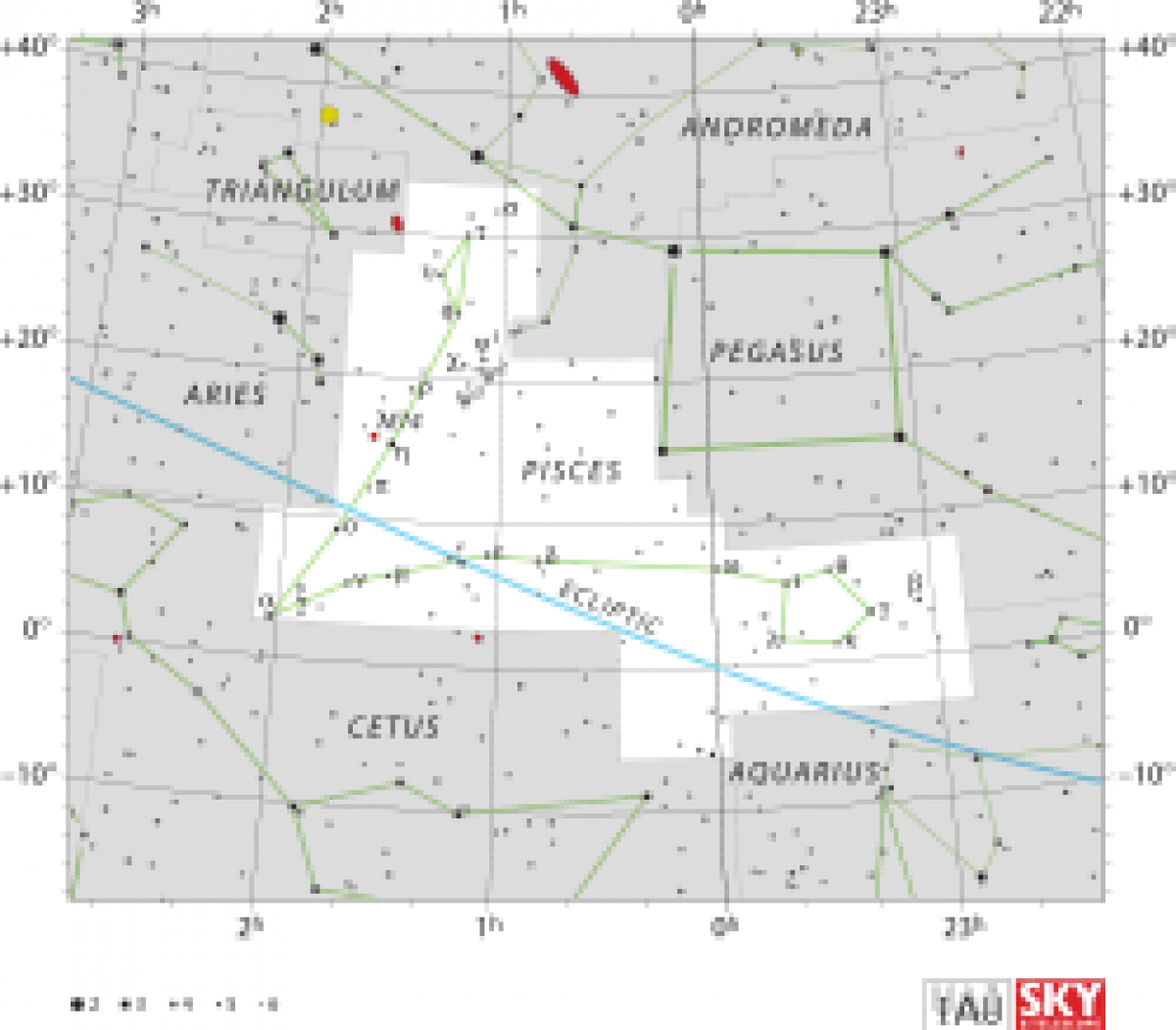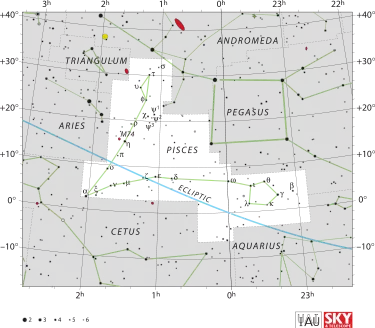 Image: The constellation Pisces as seen with the naked eye.
Image: The constellation Pisces as seen with the naked eye.
Welcome to the captivating world of the Pisces constellation! In this journey, we will dive into the rich history, fascinating features, and intriguing mythology surrounding this celestial wonder. So, grab your stargazing gear and let's embark on an unforgettable adventure.
Unveiling the Features of Pisces
At first glance, you might mistake Pisces for a mere collection of stars. But this constellation holds many secrets. Located in the Northern celestial hemisphere, Pisces is known as a distant pair of fishes connected by a cord. Its name, Latin for "fishes," perfectly captures the essence of this constellation.
 Image: The constellation Pisces as seen by the naked eye.
Image: The constellation Pisces as seen by the naked eye.
Pisces sits between the similarly sized Aquarius to the southwest and the smaller Aries to the east. The ecliptic and celestial equator intersect within Pisces, making it a significant point in the sky, particularly during the March equinox.
A Stellar Ensemble
Although Pisces covers a large area in the sky, it is home to only a few notable stars. Alrescha, also known as Alpha Piscium, shines as one of the brightest stars in the constellation. Delta Piscium, Epsilon Piscium, and Alpherg (Eta Piscium) are among the other remarkable stars residing in Pisces.
 Image: Van Maanen's Star, the closest-known solitary white dwarf.
Image: Van Maanen's Star, the closest-known solitary white dwarf.
But the true gem of Pisces might just be Van Maanen's Star. While it remains invisible to the naked eye, this solitary white dwarf, located near Delta Piscium, captivates astronomers with its unique characteristics. With a dim apparent magnitude, Van Maanen's Star is the closest-known solitary white dwarf to us.
Deep-Sky Wonders
Pisces enchants us not only with its stars but also with its deep-sky objects. M74, a spiral galaxy located 30 million light-years away, showcases clusters of young stars and nebulae, offering a glimpse into the cosmic symphony of star formation. NGC 488, an isolated face-on prototypical spiral galaxy, and NGC 520, a pair of colliding galaxies, further expand Pisces' celestial repertoire. And let's not forget about CL 0024+1654, a massive galaxy cluster that acts as a lens, creating mesmerizing images of background galaxies.
Mythology and Ancient Wisdom
Pisces has captivated the human imagination for centuries, and its mythology tells tales of love, transformation, and resilience. In ancient Greek legends, Aphrodite (Venus) and her son Eros (Cupid) shape-shifted into fishes to escape the monster Typhon, or were carried away to safety on the backs of two fishes. This mythological connection adds an element of enchantment to the Pisces constellation.
 Image: Pisces in Hevelius' map (1690)
Image: Pisces in Hevelius' map (1690)
In Chinese astronomy, Pisces played a significant role, intertwined with stories of marshes and enclosures. The stars of Pisces found their place in constellations like Wai-ping (Outer Enclosure) and Koui-siou (House of the Sandal).
Unlocking the Mysteries of Pisces
As we conclude our celestial journey through the Pisces constellation, we are left in awe of the wonders it holds. From its alluring stars to its captivating mythology, Pisces invites us to explore the mysteries of the cosmos and connect with the ancient wisdom passed down through generations.
So, grab your telescope, find a spot away from city lights, and let Pisces guide you on a celestial adventure that will leave you starstruck and inspired.
References:
- Ridpath, Ian. Star Tales. James Clarke & Co, 1988.
- Ridpath, Ian; Tirion, Wil. Stars and Planets Guide (4th ed.). Princeton University Press, 2007.
- Eratosthenes, Hyginus, Aratus. Edited by Robin Hard. Constellation Myths: with Aratus's Phaenomena. OUP Oxford, 2015.
- Allen, Richard Hinckley. Star Names, Their Lore and Legend.
- Staal, Julius D. W. The New Patterns in the Sky: Myths and Legends of the Stars. The McDonald and Woodward Publishing Company, 1988.
- Hamilton, Thomas Wm. Useful Star Names. Strategic Books, 2008.

















